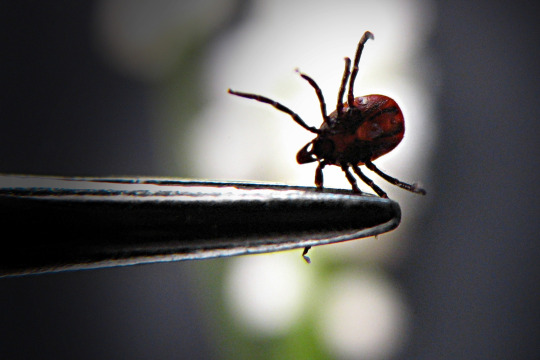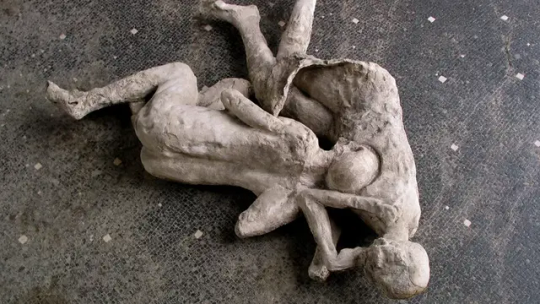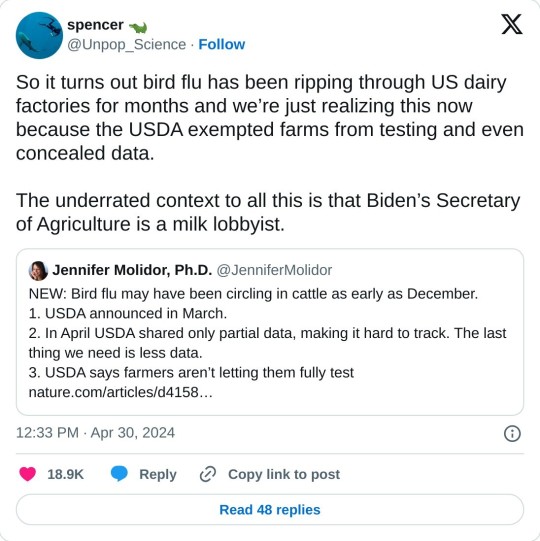#genomic data analysis
Explore tagged Tumblr posts
Text
#bioinformatics tools#application of bioinformatics#bioinformatics data#bioinformatics database#next generation sequencing data analysis#genomic data analysis#bioinformatics analysis
0 notes
Text


20.5.24
My amazing and supportive pi sent me a pic of blue tit for inspo. Need to share alongside with my finally emerging metadata table ⭐
#grad school#gradblr#phdblr#studyblr#study motivation#studyspo#academia#genomics#study notes#birds#birding#data analysis
9 notes
·
View notes
Text
A protein found in human sweat may protect against Lyme disease
New Post has been published on https://thedigitalinsider.com/a-protein-found-in-human-sweat-may-protect-against-lyme-disease/
A protein found in human sweat may protect against Lyme disease


Lyme disease, a bacterial infection transmitted by ticks, affects nearly half a million people in the United States every year. In most cases, antibiotics effectively clear the infection, but for some patients, symptoms linger for months or years.
Researchers at MIT and the University of Helsinki have now discovered that human sweat contains a protein that can protect against Lyme disease. They also found that about one-third of the population carries a genetic variant of this protein that is associated with Lyme disease in genome-wide association studies.
It’s unknown exactly how the protein inhibits the growth of the bacteria that cause Lyme disease, but the researchers hope to harness the protein’s protective abilities to create skin creams that could help prevent the disease, or to treat infections that don’t respond to antibiotics.
“This protein may provide some protection from Lyme disease, and we think there are real implications here for a preventative and possibly a therapeutic based on this protein,” says Michal Caspi Tal, a principal research scientist in MIT’s Department of Biological Engineering and one of the senior authors of the new study.
Hanna Ollila, a senior researcher at the Institute for Molecular Medicine at the University of Helsinki and a researcher at the Broad Institute of MIT and Harvard, is also a senior author of the paper, which appears today in Nature Communications. The paper’s lead author is Satu Strausz, a postdoc at the Institute for Molecular Medicine at the University of Helsinki.
A surprising link
Lyme disease is most often caused by a bacterium called Borrelia burgdorferi. In the United States, this bacterium is spread by ticks that are carried by mice, deer, and other animals. Symptoms include fever, headache, fatigue, and a distinctive bulls-eye rash.
Most patients receive doxycycline, an antibiotic that usually clears up the infection. In some patients, however, symptoms such as fatigue, memory problems, sleep disruption, and body aches can persist for months or years.
Tal and Ollila, who were postdocs together at Stanford University, began this study a few years ago in hopes of finding genetic markers of susceptibility to Lyme disease. To that end, they decided to run a genome-wide association study (GWAS) on a Finnish dataset that contains genome sequences for 410,000 people, along with detailed information on their medical histories.
This dataset includes about 7,000 people who had been diagnosed with Lyme disease, allowing the researchers to look for genetic variants that were more frequently found in people who had had Lyme disease, compared with those who hadn’t.
This analysis revealed three hits, including two found in immune molecules that had been previously linked with Lyme disease. However, their third hit was a complete surprise — a secretoglobin called SCGB1D2.
Secretoglobins are a family of proteins found in tissues that line the lungs and other organs, where they play a role in immune responses to infection. The researchers discovered that this particular secretoglobin is produced primarily by cells in the sweat glands.
To find out how this protein might influence Lyme disease, the researchers created normal and mutated versions of SCGB1D2 and exposed them to Borrelia burgdorferi grown in the lab. They found that the normal version of the protein significantly inhibited the growth of Borrelia burgdorferi. However, when they exposed bacteria to the mutated version, twice as much protein was required to suppress bacterial growth.
The researchers then exposed bacteria to either the normal or mutated variant of SCGB1D2 and injected them into mice. Mice injected with the bacteria exposed to the mutant protein became infected with Lyme disease, but mice injected with bacteria exposed to the normal version of SCGB1D2 did not.
“In the paper we show they stayed healthy until day 10, but we followed the mice for over a month, and they never got infected. This wasn’t a delay, this was a full stop. That was really exciting,” Tal says.
Preventing infection
After the MIT and University of Helsinki researchers posted their initial findings on a preprint server, researchers in Estonia replicated the results of the genome-wide association study, using data from the Estonian Biobank. These data, from about 210,000 people, including 18,000 with Lyme disease, were later added to the final Nature Communications study.
The researchers aren’t sure yet how SCGB1D2 inhibits bacterial growth, or why the variant is less effective. However, they did find that the variant causes a shift from the amino acid proline to leucine, which may interfere with the formation of a helix found in the normal version.
They now plan to investigate whether applying the protein to the skin of mice, which do not naturally produce SCGB1D2, could prevent them from being infected by Borrelia burgdorferi. They also plan to explore the protein’s potential as a treatment for infections that don’t respond to antibiotics.
“We have fantastic antibiotics that work for 90 percent of people, but in the 40 years we’ve known about Lyme disease, we have not budged that,” Tal says. “Ten percent of people don’t recover after having antibiotics, and there’s no treatment for them.”
“This finding opens the door to a completely new approach to preventing Lyme disease in the first place, and it will be interesting to see if it could be useful for preventing other types of skin infections too,” says Kara Spiller, a professor of biomedical innovation in the School of Biomedical Engineering at Drexel University, who was not involved in the study.
The researchers note that people who have the protective version of SCGB1D2 can still develop Lyme disease, and they should not assume that they won’t. One factor that may play a role is whether the person happens to be sweating when they’re bitten by a tick carrying Borrelia burgdorferi.
SCGB1D2 is just one of 11 secretoglobin proteins produced by the human body, and Tal also plans to study what some of those other secretoglobins may be doing in the body, especially in the lungs, where many of them are found.
“The thing I’m most excited about is this idea that secretoglobins might be a class of antimicrobial proteins that we haven’t thought about. As immunologists, we talk nonstop about immunoglobulins, but I had never heard of a secretoglobin before this popped up in our GWAS study. This is why it’s so fun for me now. I want to know what they all do,” she says.
The research was funded, in part, by Emily and Malcolm Fairbairn, the Instrumentarium Science Foundation, the Academy of Finland, the Finnish Medical Foundation, the Younger Family, and the Bay Area Lyme Foundation.
#000#Analysis#Animals#antibiotic#Antibiotics#antimicrobial#approach#Bacteria#Biological engineering#Biology#Broad Institute#Cells#communications#data#Delay#Disease#disruption#engineering#eye#factor#fatigue#Finland#Foundation#Full#genetic#Genetics#genome#growth#how#human
2 notes
·
View notes
Text
youtube
#Machine learning#colorectal cancer#prognostic signature#epitranscriptomics#m6A modification#m1A modification#m5C modification#m7G modification#bioinformatics#survival prediction#cancer biomarkers#precision oncology#AI in healthcare#omics analysis#feature selection#deep learning#big data#genomics#risk stratification#personalized medicine.#Youtube
0 notes
Text
Python-Based Pipelines for Variant Calling in Genomic Research

In the rapidly evolving field of genomics, variant calling is a cornerstone of genomic research that enables scientists to identify genetic variations associated with diseases, traits, and evolutionary processes. With the exponential growth of high-throughput sequencing technologies, researchers are now faced with vast amounts of genomic data, necessitating efficient and robust tools for analysis. Python, a versatile programming language with a rich ecosystem of libraries, has become a popular choice for developing variant calling pipelines. In this article, we will explore how to create Python-based pipelines for variant calling, focusing on the process of handling VCF files, and illustrating how Python can transform genomic data into meaningful discoveries.
To know more, visit us at: https://edgenebiomed.com/
1 note
·
View note
Text
🌟 Unlock the Future of Medicine with Genomic Data Analysis! 🧬 Dive into cutting-edge techniques that are transforming healthcare and personalizing treatments. Join the genomic revolution! 🚀 #Genomics #DataAnalysis #PrecisionMedicine #HealthInnovation #FutureOfMedicine
#🌟 Unlock the Future of Medicine with Genomic Data Analysis! 🧬 Dive into cutting-edge techniques that are transforming healthcare and persona#Genomics#DataAnalysis#PrecisionMedicine#HealthInnovation#FutureOfMedicine
0 notes
Text
How Artificial Intelligence is Transforming Scientific Research
Introduction No one ever imagined how artificial intelligence would revolutionize scientific research. At TechtoIO, we look into how AI is not just a tool but the driver behind the rapid advancements in many scientific disciplines. That includes how science is being transformed—from better data analysis to catalyzing discovery, such as areas in health, climate science, physics, particle experimentation, and more. Read to continue link...
#Science Explained#TagsAI accelerating discoveries#AI and environmental monitoring#AI bias mitigation#AI data analysis#AI data privacy#AI future advancements#AI in astronomy#AI in climate science#AI in genomics#AI in healthcare research#AI in material science#AI in social sciences#AI in space exploration#AI medical image analysis#AI predictive analytics#AI simulations in science#AI transforming science#AI-driven drug discovery#artificial intelligence in scientific research#ethical AI in research#analysis#nvidia drive#science updates#tech news#adobe cloud#business tech#trends#science#technology
0 notes
Text
"Revolutionizing Biotech: How AI is Transforming the Industry"
The biotech industry is on the cusp of a revolution, and Artificial Intelligence (AI) is leading the charge. AI is transforming the way biotech researchers and developers work, enabling them to make groundbreaking discoveries and develop innovative solutions at an unprecedented pace. “Accelerating Scientific Discovery with AI” AI is augmenting human capabilities in biotech research, enabling…

View On WordPress
#Agricultural Biotech#agriculture#ai#Artificial Intelligence#bioinformatics#Biological Systems#Biomedical Engineering.#Biotech#Data Analysis#Drug Discovery#Environment#genetics#genomics#healthcare#innovation#Machine Learning#personalized medicine#Precision Medicine#Research#science#synthetic biology#technology
0 notes
Text

Advanced Workflow Builder
Introducing our innovative platform: a user-friendly interface, pre-built workflows, and open-source tools for seamless collaboration. No coding expertise required; optimize team efforts from anywhere. From concept to production, streamline pipeline development effortlessly. Identify errors easily with our visual format. Accelerate workflows with precision and efficiency.
1 note
·
View note
Text
Data-Driven Discovery: How Genomic Analysis Services Spark New Ideas
In the scientific field, genomic analysis services are the catalysts for groundbreaking discoveries, unraveling the mysteries encoded within our RNA and DNA. With the power of data-driven insights, researchers and scientists are charting new territories, uncovering hidden patterns, and unlocking the potential of genomic information. This exploration will help you understand the fascinating world of genomic data analysis services and their pivotal role in sparking innovation and reshaping the landscape of scientific discovery.
Read More :- https://theamberpost.com/post/data-driven-discovery-how-genomic-analysis-services-spark-new-ideas
0 notes
Text
https://justpaste.it/f7dbu
#bioinformatics projects#ai bioinformatics#genomics in bioinformatics#microarray in bioinformatics#computational genomics#computational genetics#bioinformatics services#bioinformatics analysis of ngs data
0 notes
Text
A new way to determine whether a species will successfully invade an ecosystem
New Post has been published on https://thedigitalinsider.com/a-new-way-to-determine-whether-a-species-will-successfully-invade-an-ecosystem/
A new way to determine whether a species will successfully invade an ecosystem


When a new species is introduced into an ecosystem, it may succeed in establishing itself, or it may fail to gain a foothold and die out. Physicists at MIT have now devised a formula that can predict which of those outcomes is most likely.
The researchers created their formula based on analysis of hundreds of different scenarios that they modeled using populations of soil bacteria grown in their laboratory. They now plan to test their formula in larger-scale ecosystems, including forests. This approach could also be helpful in predicting whether probiotics or fecal microbiota treatments (FMT) would successfully combat infections of the human GI tract.
“People eat a lot of probiotics, but many of them can never invade our gut microbiome at all, because if you introduce it, it does not necessarily mean that it can grow and colonize and benefit your health,” says Jiliang Hu SM ’19, PhD ’24, the lead author of the study.
MIT professor of physics Jeff Gore is the senior author of the paper, which appears today in the journal Nature Ecology and Evolution. Matthieu Barbier, a researcher at the Plant Health Institute Montpellier, and Guy Bunin, a professor of physics at Technion, are also authors of the paper.
Population fluctuations
Gore’s lab specializes in using microbes to analyze interspecies interactions in a controlled way, in hopes of learning more about how natural ecosystems behave. In previous work, the team has used bacterial populations to demonstrate how changing the environment in which the microbes live affects the stability of the communities they form.
In this study, the researchers wanted to study what determines whether an invasion by a new species will succeed or fail. In natural communities, ecologists have hypothesized that the more diverse an ecosystem is, the more it will resist an invasion, because most of the ecological niches will already be occupied and few resources are left for an invader.
However, in both natural and experimental systems, scientists have observed that this is not consistently true: While some highly diverse populations are resistant to invasion, other highly diverse populations are more likely to be invaded.
To explore why both of those outcomes can occur, the researchers set up more than 400 communities of soil bacteria, which were all native to the soil around MIT. The researchers established communities of 12 to 20 species of bacteria, and six days later, they added one randomly chosen species as the invader. On the 12th day of the experiment, they sequenced the genomes of all the bacteria to determine if the invader had established itself in the ecosystem.
In each community, the researchers also varied the nutrient levels in the culture medium on which the bacteria were grown. When nutrient levels were high, the microbes displayed strong interactions, characterized by heightened competition for food and other resources, or mutual inhibition through mechanisms such as pH-mediated cross-toxin effects. Some of these populations formed stable states in which the fraction of each microbe did not vary much over time, while others formed communities in which most of the species fluctuated in number.
The researchers found that these fluctuations were the most important factor in the outcome of the invasion. Communities that had more fluctuations tended to be more diverse, but they were also more likely to be invaded successfully.
“The fluctuation is not driven by changes in the environment, but it is internal fluctuation driven by the species interaction. And what we found is that the fluctuating communities are more readily invaded and also more diverse than the stable ones,” Hu says.
In some of the populations where the invader established itself, the other species remained, but in smaller numbers. In other populations, some of the resident species were outcompeted and disappeared completely. This displacement tended to happen more often in ecosystems when there were stronger competitive interactions between species.
In ecosystems that had more stable, less diverse populations, with stronger interactions between species, invasions were more likely to fail.
Regardless of whether the community was stable or fluctuating, the researchers found that the fraction of the original species that survived in the community before invasion predicts the probability of invasion success. This “survival fraction” could be estimated in natural communities by taking the ratio of the diversity within a local community (measured by the number of species in that area) to the regional diversity (number of species found in the entire region).
“It would be exciting to study whether the local and regional diversity could be used to predict susceptibility to invasion in natural communities,” Gore says.
Predicting success
The researchers also found that under certain circumstances, the order in which species arrived in the ecosystem played a role in whether an invasion was successful. When the interactions between species were strong, the chances of a species becoming successfully incorporated went down when that species was introduced after other species have already become established.
When the interactions are weak, this “priority effect” disappears and the same stable equilibrium is reached no matter what order the microbes arrived in.
“Under a strong interaction regime, we found the invader has some disadvantage because it arrived later. This is of interest in ecology because people have always found that in some cases the order in which species arrived matters a lot, while in the other cases it doesn’t matter,” Hu says.
The researchers now plan to try to replicate their findings in ecosystems for which species diversity data is available, including the human gut microbiome. Their formula could allow them to predict the success of probiotic treatment, in which beneficial bacteria are consumed orally, or FMT, an experimental treatment for severe infections such as C. difficile, in which beneficial bacteria from a donor’s stool are transplanted into a patient’s colon.
“Invasions can be harmful or can be good depending on the context,” Hu says. “In some cases, like probiotics, or FMT to treat C. difficile infection, we want the healthy species to invade successfully. Also for soil protection, people introduce probiotics or beneficial species to the soil. In that case people also want the invaders to succeed.”
The research was funded by the Schmidt Polymath Award and the Sloan Foundation.
#Analysis#approach#author#Bacteria#Community#competition#data#diversity#Ecology#Ecosystems#effects#Environment#Evolution#experimental#factor#Food#form#Foundation#Fraction#genomes#gut#gut microbiome#Health#how#human#infection#infections#interaction#it#learning
0 notes
Text
youtube
#ZFNet#Deep Maxout Network#cancer prediction#gene expression data#convolutional neural networks#genomic analysis#cancer classification#deep learning#machine learning#precision medicine#bioinformatics#computational oncology#dimensionality reduction#cancer diagnosis#AI in healthcare#personalized medicine#cancer detection#genomic biomarkers#neural networks#cancer subtypes.#Youtube
0 notes
Text

A photo of the body casts of two adults and two children who died in what's now called the house of the golden bracelet in Pompeii. A new DNA analysis shows that these four people are not genetically related to one another. (Image credit: Archeological Park of Pompeii).
DNA Analysis Rewrites The Stories of People Buried in Pompeii
An ancient-DNA analysis of victims in Pompeii who died in Mount Vesuvius' eruption reveals some unusual relations between the people who died together.
Ancient DNA taken from the Pompeii victims of Mount Vesuvius' eruption nearly 2,000 years ago reveals that some people's relationships were not what they seemed, according to a new study.
For instance, an adult who was wearing a golden bracelet and holding a child on their lap was long thought to be a mother with her child. But the new DNA analysis revealed that, in reality, the duo were "an unrelated adult male and child," study co-author David Reich, a professor of genetics at Harvard Medical School, said in a statement.
In another example, a couple who died in an embrace and were "thought to be sisters, or mother and daughter, were found to include at least one genetic male," Reich said. "These findings challenge traditional gender and familial assumptions."
In the study, published Thursday (Nov. 7) in the journal Current Biology, Reich and an international team of researchers looked at the genetics of five individuals who died during the A.D. 79 eruption that killed around 2,000 people.
When Mount Vesuvius erupted, it covered the surrounding area in a deadly layer of volcanic ash, pumice and pyroclastic flow, burying people alive and preserving the shapes of many bodies beneath the calcified layers of ash. The remains of the city were rediscovered only in the 1700s. In the following century, archaeologist Giuseppe Fiorelli perfected his plaster technique, in which he filled in the human-shaped holes left after the bodies had decomposed to create casts of the victims.

The casts of two people who died about 2,000 years ago in the house of the cryptoporticus in Pompeii. A new DNA analysis found that one individual was biologically male, but the sex of the other could not be determined. (Image credit: Archeological Park of Pompeii).
The casts allowed scholars to study the victims in their last moments and make hypotheses about their identities based on details such as their locations, positions and apparel. The problem with this approach, however, was that their interpretations were influenced by modern-day assumptions — for instance, that the four people at the house with the golden bracelet, which included the adult holding the child, were two parents with their children, when in reality none of them were genetically related, the researchers wrote in the study.
For their research, the team analyzed 14 casts and extracted DNA from fragmented skeletal remains in five of them. By analyzing this genetic material, the scientists determined the individuals' genetic relationships, sex and ancestry. The team concluded that the victims had a "diverse genomic background," primarily descending from recent eastern Mediterranean immigrants, per the statement, confirming the Roman Empire's multiethnic reality.

The cast of a person who died in the villa of the mysteries in Pompeii in A.D. 79. (Image credit: Archeological Park of Pompeii).
Our findings have significant implications for the interpretation of archaeological data and the understanding of ancient societies," study co-author Alissa Mittnik, an archaeogeneticist at Harvard Medical School and the Max Planck Institute for Evolutionary Anthropology in Germany, said in the statement. "They highlight the importance of integrating genetic data with archaeological and historical information to avoid misinterpretations based on modern assumptions."
It's possible that past misconceptions led to the "exploitation of the casts as vehicles for storytelling," meaning that curators may have manipulated the victims' "poses and relative positioning" for exhibits, the team wrote in the study.
Sex misassignment is "not uncommon" in archaeology, Carles Lalueza-Fox, a biologist at the Institute of Evolutionary Biology (CSIC-UPF) in Barcelona who specializes in the study of ancient DNA but was not involved with the study, said in an email.
"Of course we look at the past with the cultural eyes of the present and this view is sometimes distorted; for me the discovery of a man with a golden bracelet trying to save an unrelated child is more interesting and culturally complex than assuming it was a mother and her child," Lalueza-Fox said.
By Margherita Bassi.



#DNA Analysis Rewrites The Stories of People Buried in Pompeii#Pompeii#Mount Vesuvius' eruption#dna#dna test#ancient artifacts#archeology#archeolgst#history#history news#ancient history#ancient culture#ancient civilizations#roman history#roman empire
279 notes
·
View notes
Text
How Big Data Analytics is Changing Scientific Discoveries
Introduction
In the contemporary world of the prevailing sciences and technologies, big data analytics becomes a powerful agent in such a way that scientific discoveries are being orchestrated. At Techtovio, we explore this renewed approach to reshaping research methodologies for better data interpretation and new insights into its hastening process. Read to continue
#CategoriesScience Explained#Tagsastronomy data analytics#big data analytics#big data automation#big data challenges#big data in healthcare#big data in science#big data privacy#climate data analysis#computational data processing#data analysis in research#data-driven science#environmental research#genomics big data#personalized medicine#predictive modeling in research#real-time scientific insights#scientific data integration#scientific discoveries#Technology#Science#business tech#Adobe cloud#Trends#Nvidia Drive#Analysis#Tech news#Science updates#Digital advancements#Tech trends
1 note
·
View note
